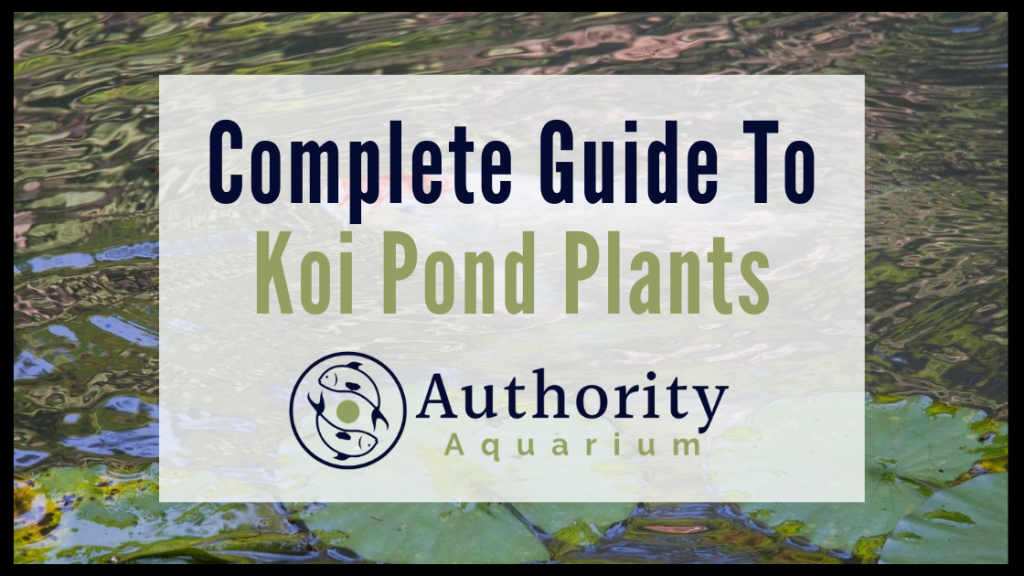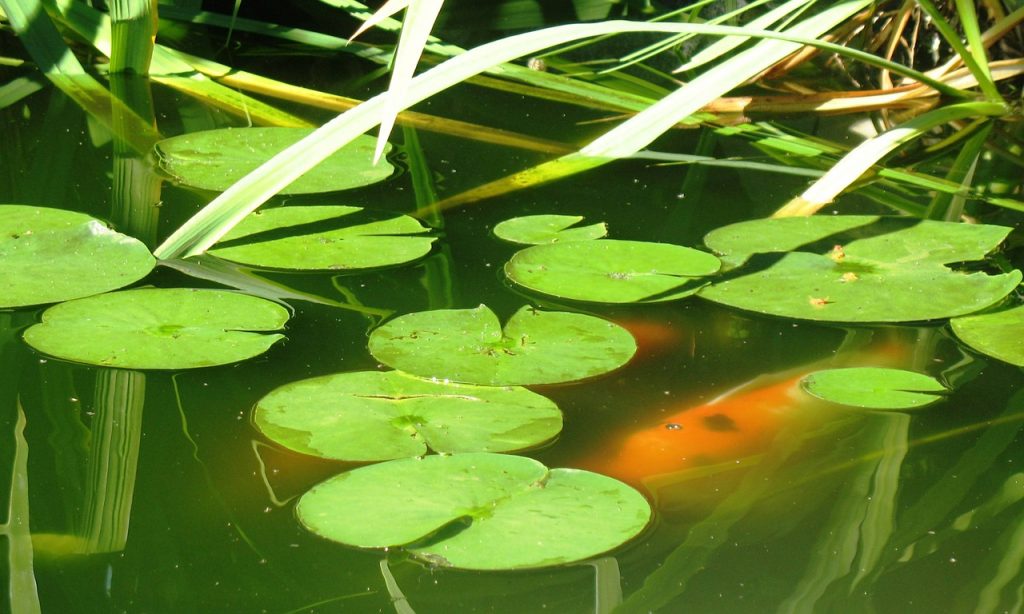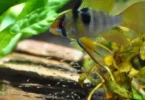Last Updated on April 24, 2023 by Coral Realm
Koi are colored varieties of the Amur Carp (Cyprinus rubrofuscus) which are most commonly kept in outdoor koi ponds and water gardens.
They are very hardy coldwater fish which like to be kept in at least a meter of water in temperatures of between 59 to 77°F (15 to 20°C). Their immune systems become weakened if the temperature drops below 50°F, or 10°C, and so generally do not do well in protracted cold winters.
Koi are omnivorous, which means they will eat just about anything! This does mean that they will try and eat any plants you put in your Koi pond. This article details which Koi pond plants will be suitable for you.

IN THIS ARTICLE
Why Should You Have Koi Pond Plants?
Aquatic plants will provide your Koi pond with an array of essential functions. They oxygenate the water, as well as providing natural filtration which helps to keep your fish healthy.
This natural filtration keeps chemicals and fertilizers such as nitrates and ammonia, which can directly affect your fish as well as causing and promoting harmful algal growth, which can soon overrun your pond ecosystem. This effect along with a good fish pond filter will ensure your pond is kept sparkling.
Having plants in your Koi carp pond will also increase the biodiversity of your pond. Plants provide shelter and safety to numerous animals such as frogs, snails, and other invertebrates. While you may think you don’t want these in your pond, having a higher biodiversity will only increase the overall health of your pond, including the prized Koi carp. Your pond will also look a lot more natural.
Surface plants provide shade to the bottom of the pond, which as Koi prefer colder waters, is very useful especially if you live in a hot climate. This shaded water will help to regulate the water temperature of the whole pond, so the pond doesn’t fluctuate to extremes depending on the level of sunshine.
List of Best Koi Pond Plants
Here we will list the 7 best koi pond plants you can get. This list is based on the advantages of shelter, filtration, and benefit to your koi carp. All of these choices will look amazing in your koi carp pond. Read the list and see which you want most!
1) Water Lotus (Nelumbo lutea)
The american water lotus is a stunning plant to have in your koi pond. Producing beautiful flowers they will end up one of your most prized plants.
They are very easy to keep as well, not requiring much maintenance or upkeep at all. However they do prefer certain conditions. They can grow to be quite large, so they like larger koi ponds. The pad like leaves can grow to be up to two feet across!
Water Lotus prefer at least 18 inches of water, which is good as Koi like at least a meter of water! They also have a preferred temperature range of 75 to 87°F (24 – 30.5°C). They like to sunbathe, and prefer to be in sunlight. Check out our article on how much sunlight do ponds need for more general information.
The large eaves will provide your koi with plenty of shade, especially in the summer months, and while koi will nibble at them they won’t be destroyed.
2) Water Lettuce (Pistia stratiotes)
Water lettuce is a very beautiful floating koi pond plant. Its leaves resemble a rose in bloom, and they provide shelter and shade for your koi, as well as providing a great deal of natural filtration.
The roots of water lettuce can grow as much as two feet in length. Your koi will love swimming amongst these roots and taking a bite!
It is very easy to grow and keep water lettuce as it is a very hardy plant, which is very it is invasive in many ecosystems. They can grow in virtually any depth koi pond, but do prefer a temperature range of 66 – 80°F (19 – 27°C) however.
It is worth noting that the sale and movement of water lettuce is illegal in the states of Florida, Alabama, Connecticut, California, and South Carolina.
3) Horsetail (Equisetum)
Horsetail is quite a fascinating koi pond plant. It is known as a living fossil. Equisetum is the only living genus of the subclass Equisetidae which dates back over 100 million years. They reproduce using spores rather than seeds. Having this plant in your koi pond is like having a small piece of the distant past.
They grow along the edges of a body of water, much like reeds. They grow in segments which hold water. Horsetail won’t crowd into your koi pond or provide too much competition for other koi pond plants you might have.
They look amazing along the edge of any pond and will ensure you have a natural feel to your koi pond.
4) Water Hyacinth (Eichhornia crassipes)
Water hyacinth is known for its stunning lavender-blue colored flowers and broad, thick, leaves which float above the surface and measure around six inches across. The long spongy stalks may end up being around one meter above the water surface!
The roots are purple black and hang freely beneath the plant. Water hyacinth is a very hardy plant that grows very quickly and in a wide range of conditions. Koi will nibble on this plant and will actually help in keeping the growth in check!
The flowers will attract bees and hummingbirds, which are amazing to watch above your koi pond. And they are important pollinators which is an added bonus!
5) Eelgrass (Vallisneria americana)
Also known as Jungle Vals, Eelgrass is extremely hardy and will be guaranteed to thrive in your koi pond.It is one of the earliest plants to be used in ponds and aquariums. They like shallow water up to ten feet deep, so ponds are a perfect home for them.
The jungle of leaves it creates underwater is a perfect refuge to numerous animals and invertebrates. You koi will love using this refuge too.
6) Water Poppy
A truly beautiful plant, the Water Poppy may be one of nature’s most graceful floating plants. They add a lovely carpet of foliage and a really natural look to any pond edge.
They have dark green, heart shaped leaves which are around three inches long and grow along, long trailing stems. This plant blooms into beautiful yellow flowers. The flowers bloom in the summer, normally between June and August, so you get to enjoy the flowers at the best time of year. The main body of the plant thrives all year though.
7) Water Lily
Water lilies are one of the most well known and distinctive koi pond plants, and for good reason! These are stunning plants with their flat, round, floating leaves and wonderful flowers.
The water lily provides amazing decoration together with cool, shady havens for your koi and any wild pond dwellers that inhabit your garden pond. As koi like shaded areas they will love water lilies.
There are a multitude of different varieties of water lily to choose from. All are stunning but some are larger than others so make sure you know how much they will grow. You don’t want the leaves to spread across more than two thirds of the pond surface.
Will Koi Eat Pond Plants?

Koi carp are notoriously greedy and unfussy eaters. They are omnivores which eat basically anything! So yes, they will nibble and try and take a few chunks out of the plants you put in your koi pond.
This doesn’t have to be seen as a bad thing though. Some koi pond plants will grow quickly, and can get out of hand unless you manage them properly. With your koi eating the roots and nibbling the leaves they will do it for you!
This can be beneficial to the fish as well, as the plant leaves and roots will contain valuable nutrients which will supplement their diet and keep them healthy.
Ensuring Koi Pond Plant Growth and Health
You can maximize the growth of your koi pond plants by using fertilizers if they are looking unhealthy.
If your koi are nibbling at your plants too much you can do a few things to try and prevent them from damaging the plants. Having a mesh around the root system can be a good idea to prevent the koi from getting it all up.
If your koi are eating entire plants and are devouring your picturesque plants you have worked hard to plant, it could be a sign that you aren’t feeding them enough. Try feeding them a little more often, or try a feed which has greater nutrient levels so they don’t feel the need to go after your plants.
- Floating pellets allow easy monitoring of amount eaten
- Will not cloud water
- Supports immune system health
- Promotes long healthy life
- Contains stabilized vitamin C
Also keeping the pond water properly filtered and maintained will ensure the correct conditions for your koi pond plants to thrive! A UV sterilizer will help to keep the water clear of algae and the water nice and clear.
Conclusion
Having plants in your koi pond is a great thing. It will make your pond look a lot more natural, and will provide your koi with much needed shade. They also provide shade and shelter for other species and help to attract pond frogs, and enhance the biodiversity of your pond.
They will also provide natural filtration and will increase the overall biodiversity of your koi pond by providing hiding places for invertebrates and other organisms. Your koi will also eat these inverts, and also nibble on the plants, supplementing their diet.
You may also like the following articles:
- Pond Shade Guide – Can Fish Ponds Thrive In Shady Conditions?














